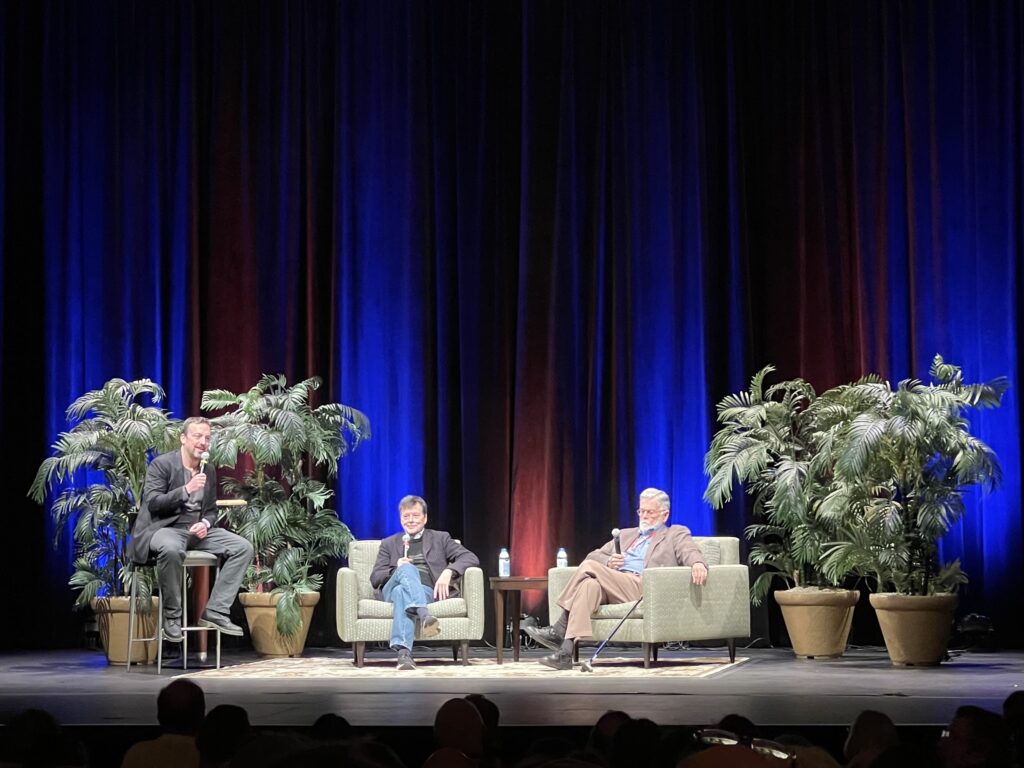Ken Burns Presents “Art” at the Majestic Theater
By Victoria Staub, Arts and Entertainment Editor

Ken Burns discusses “Art” clip reel with filmmaker Jake Boritt and writer and editor Geoffrey Ward (Photo Victoria Staub/The Gettysburgian).
On Saturday, famed documentarian Ken Burns discussed the theme of art within his films, starting off the event with a short compilation of clips from his documentaries which Burns referred to as a “mixtape.”
Following this, Burns was joined onstage at the Majestic Theater by Gettysburg native and filmmaker Jake Boritt as the moderator as well as writer and editor Geoffrey Ward, who has worked alongside Burns on many films. Burns and Ward were referred to as the Lennon and McCartney of documentaries.
The so-called “mixtape” for this session, formerly titled “Ken Burns Presents ‘Art,’ Thematic Clip Reel” contained clips from eight episodes of Burns’ films. The included episodes were: “The Language of Music” from “Jazz,” “Steel Poetry” from “Brooklyn Bridge,” “Twain’s Masterpiece” from “Mark Twain,” “The Jefferson City Mural” from “Thomas Hart Benton,” “Fallingwater” from “Frank Lloyd Wright,” “Woody Guthrie” from “The Dust Bowl,” and “Ansel Adams” from “The National Parks.”
These clips were a starting point for the event, as they sparked a lively discussion about both the art displayed in the films and the films themselves as art.
The presence of art within these films was highlighted with lines such as, “[jazz musicians] can speak to each other in the language of music,” “Mark Twain liberated American literature,” and “the treatment of the farm workers politicized [Guthrie] and his music.”
“Jazz” was discussed frequently, as two clips from this film were featured in the presented “mixtape.” Burns and Ward spoke of the incredible talent of Wynton Marsalis, who inspired the episode title, by referring to jazz as “the language of music.” They discussed the difficulty of placing a “bite,” or clip, of him discussing race and jazz in the film.
Burns explained that the editing process is much like making maple syrup, as it takes “40 gallons of sap to make one gallon of maple syrup,” meaning that film must be expertly selected and placed to tell the story in an orderly fashion. He explained that he eventually found a spot for Marsalis’ quote when the history took him to the popularity of jazz music in white communities as white people began to write out the black Americans who invented jazz.
Burns and Ward highlighted the idea that the writing of these documentaries is meant to present history like a story that audiences do not know the ending to. Burns explained that he has been approached by people who watched his documentary “The Civil War” and hoped Lincoln would not die in Ford’s Theater, despite knowing the history. He called this “the essence of good history.”
Burns noted additionally that filmmakers should be telling a story with their films, not forcing information upon their audiences. He compared that form of filmmaking to homework and a test. To Burns, films should be more personable, and he demonstrated this with his focus on Billie Holiday in “Jazz.”
“Billie Holiday,” he said, “it’s like, she makes me cry. She’s a great artist. Can we tell you about her? … And that’s all it is. And then all the other stuff is backup.”
Burns and Ward did not always like the people they worked with or made films about on a personal level. Ward specifically took note of the fact that many of the people they focused on in this discussion of art were very flawed people, but their art was not. Frank Lloyd Wright was mentioned in particular. Understanding this concept was very important to both Burns and Ward, as they wanted to ensure that their films depicted subjects with truthful proportions of beauty and brutality.
In addition to demonstrating the art of their own filmmaking via the “mixtape” and discussion, Burns and Ward focused on the art within films rather than the films themselves. Burns and Ward explained that depicting history appropriately remains their goal with filmmaking and writing.
At the end of the event, when asked for final comments about art, Ward said, “I’m for it,” to which Burns tacked on, “me too.”
